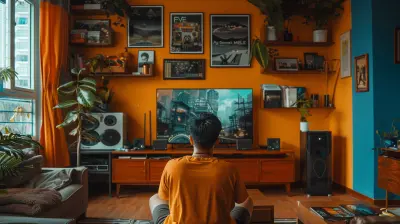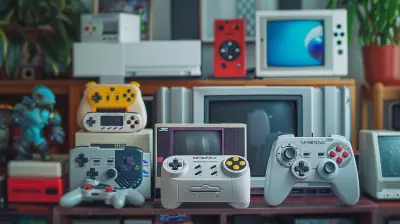Crafting a Seamless Tutorial: Onboarding Players Without Frustration
31 May 2025
Getting new players into your game is like throwing a party. You want everyone to have a good time from the moment they walk through the door. But let’s be real—first impressions matter. If your tutorial feels like a chore, it’s like handing someone a 50-page manual on how to dance. Not fun, right?
Creating a seamless tutorial isn’t just about teaching the mechanics; it’s about welcoming players, guiding them gently, and keeping them excited to dive in deeper. So, how do you craft an onboarding experience that leaves players hyped instead of heading for the exit? Let’s break it down.
Why First Impressions Are Everything
Think about the last time you tried a new game. The first few minutes probably set the tone for your entire experience. Did it pull you in with a sense of curiosity? Or did it bog you down with walls of text and overly complex instructions?For many players, the tutorial can make or break their decision to stick around. If it's too dull or confusing, you've lost them. If it's overwhelming? They're out too. A good tutorial needs to strike a delicate balance—it should be engaging but not too demanding.
In a world where players can uninstall your game with two taps, you only get one shot at hooking them. So, let’s talk about how to make that first shot count. 
The Core Principles of Player Onboarding
Before we dive into the nitty-gritty, let’s get one thing straight: a tutorial isn’t just about teaching mechanics. It’s about building trust, establishing comfort, and sparking excitement. With that in mind, here are the golden rules of onboarding:1. Start Simple, But Not Too Simple
Imagine walking into a gym for the first time, clueless about how the machines work, and someone hands you a booklet. Boring, right? Now, imagine a friendly instructor shows you how to use one machine at a time. That’s what your tutorial should feel like.Start with the basics, but don’t insult the player’s intelligence. If someone just picked up your RPG, they can probably figure out how to move their character. Instead, focus on teaching them the stuff that truly matters—things that are unique to your game.
2. Show, Don’t Tell
Let’s be honest, nobody likes reading paragraphs of text when they’re itching to play. Instead of explaining mechanics in lengthy pop-ups, let the players experience them through gameplay. For example, want to teach them how to jump? Throw an obstacle in their path that requires jumping. Want them to learn a combo move? Introduce an enemy that can only be defeated using that combo.Interactive learning is not only more engaging but also makes the information stick better.
3. Break It Down
Dumping a ton of information on players all at once is like trying to drink from a firehose—it’s overwhelming. Instead, drip-feed mechanics to them as they become relevant. Start with the essentials, then gradually layer in complexity.For instance, if your game involves crafting, don’t explain every recipe in the first five minutes. Wait until they’ve gathered resources, then introduce crafting one step at a time. The goal is to pace the learning so it feels natural and not like a crash course.
4. Make It Fun!
It’s a game, after all—so your tutorial shouldn’t feel like school. Add a dash of humor, create a quirky in-game guide character, or weave the tutorial into the story itself. The more entertaining your onboarding is, the more likely players are to enjoy it instead of enduring it.Even boring tasks like learning to open inventory screens can feel engaging if you frame them creatively. Maybe the inventory holds an exciting surprise—a rare item, or even just a silly joke.
Practical Tips for Crafting Seamless Tutorials
Now that we’ve covered the basic principles, let’s get into the practical stuff. What are the tangible steps you can take to create an onboarding experience that players love?Use Visual Cues
Sometimes, words just aren’t enough. Use arrows, glowing highlights, or subtle animations to guide players’ attention. If your game features a minimap, a flashing marker can show where they need to go next. If they need to interact with an object, make it stand out with a glow or a sparkle.Visual cues help players stay on track without feeling like they’re being micromanaged.
Avoid Overloading the Screen
Ever opened a complex game and been instantly bombarded by windows, tooltips, and text? It’s overwhelming, to say the least. Leave some breathing room. Focus on one action or concept at a time and hide unrelated buttons and UI elements until they’re needed.This prevents players from feeling like they’ve just been tossed into a cockpit full of blinking lights and levers.
Offer Freedom (But With Boundaries)
While structure is essential in a tutorial, players also need the freedom to experiment. Give them a safe space to try out the mechanics without fear of failure. Maybe it’s a training ground, a practice match, or even a sandbox mode.That said, don’t let them wander too far off track. Keep subtle nudges in place to guide them back to the main path when necessary.
Common Pitfalls to Avoid
Even the best intentions can lead to frustrating tutorials if you’re not careful. Here are some common mistakes to steer clear of:Over-Reliance on Text
We touched on this earlier, but it’s worth repeating: long blocks of text are a mood killer. Sure, some information needs to be written down, but keep it concise. Better yet, use tooltips or brief voiceovers instead of interrupting gameplay with a giant dialogue box.Assuming Too Much Knowledge
Not every player will be familiar with the genre or similar games. While you don’t want to over-explain, you also can’t assume everyone already knows what a “buff” or a “minimap” is. Find a balance that caters to newbies without alienating veterans.Making it Too Long
A tutorial shouldn’t feel like an epic quest of its own. Players are here for the main game, so get to it as quickly as possible. Keep your tutorial short and sweet, and let players learn additional mechanics naturally as they progress.Testing and Iteration: The Secret Sauce of Great Tutorials
Here’s the thing—even the most carefully planned tutorial can fail if it hasn’t been tested. Watching real players go through your onboarding process is invaluable. You’ll quickly spot pain points, confusing instructions, or moments where they seem disengaged.Gather feedback, make tweaks, and repeat the process until your tutorial feels just right. It’s an iterative process, but it’s worth every ounce of effort.
Wrapping Up: Welcoming Players with Open Arms
At the end of the day, a seamless tutorial is all about setting the stage for what’s to come. It’s your chance to say, “Hey, you’re going to love this!” If players feel comfortable, confident, and curious after your onboarding experience, you’ve done your job.Think of your tutorial as the front door to your game. Make it inviting, make it intuitive, and most importantly—make it fun. After all, happy players stick around, and isn’t that what every developer wants?
all images in this post were generated using AI tools
Category:
Game DesignAuthor:

Aurora Sharpe
Discussion
rate this article
3 comments
Nyari Dillon
Great insights! A smooth tutorial can make gaming a joy. Let’s keep players engaged and frustrated-free! Happy crafting!
June 15, 2025 at 2:37 AM

Aurora Sharpe
Thank you! I'm glad you found the insights valuable. Keeping tutorials engaging is key to a positive gaming experience! Happy crafting!
Finn Adams
What a thoughtful exploration of player onboarding! Crafting a seamless tutorial is crucial for enhancing the gaming experience and keeping frustration at bay. Your insights on engaging players right from the start are invaluable. Excited to see how developers implement these ideas in their games! Keep up the great work!
June 12, 2025 at 2:33 AM

Aurora Sharpe
Thank you for your kind words! I’m glad you found the insights helpful. Excited to see how developers will bring these ideas to life!
Valerie Conrad
Great insights! A smooth onboarding experience can truly enhance player enjoyment and retention. Developers should prioritize clarity and engagement in tutorials.
June 6, 2025 at 3:29 AM

Aurora Sharpe
Thank you! I completely agree—prioritizing clarity and engagement in tutorials is key to ensuring a positive onboarding experience for players.



